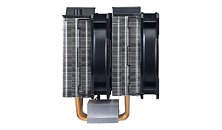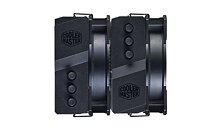Friday, March 2nd 2018

Cooler Master Introduces the MasterAir MA620P and MA621P CPU Coolers
Cooler Master, a leader in PC cooling solutions, introduces the MasterAir MA620P and MA621P that pushes the performance of air cooling beyond AIO liquid cooling. Cooler Master's supercharged heatsink is a combination of two built heatsinks with CDC 2.0 technology and two MasterFan MF120R RGB that is able to transfer and dissipate heat at extremely efficient levels. The MasterFan MF120R RGB are also certified by ASUS, Gigabyte, MSI and Asrock with their motherboard RGB sync.
Supercharged Dual Heatsink Dual ML120R RGB fans
MasterAir MA620P and MA621P TR4 edition supercharges your CPU cooling by doubling the surface area by combining two heatsinks each accompanied by two MasterFan MF120R RGB to ensure enough air pressure brings out the heat quickly enough to continually remove heat from the CPU. An optional 3rd fan is possible to take you to the next level.RGB Certified for ASUS, Gigabyte, MSI and Asrock
MasterAir MA620P and MA621P TR4 edition come with two MasterFan MF120R RGB and a RGB controller. You have the option of controlling with a click of a few buttons to set the color, intensity level and effects or use the software from the motherboard manufacturer. Because Cooler Master RGB fans are fully compatible with ASUS, Gigabyte, MSI and Asrock, you are guaranteed that full system sync of RGB is possible.
Exact fitting Base for TR4-SP3 (MA621P TR4 edition only)
MasterAir MA621P TR4 edition has an exact fitting base for the TR4-SP3 ensures the AMD Threadripper CPU has optimal surface contact and thus optimal heat transfer. The base also includes the Continuous Direct Contact Technology 2.0 (CDC 2.0), to have direct integration with heatpipes.
Supercharged Dual Heatsink Dual ML120R RGB fans
MasterAir MA620P and MA621P TR4 edition supercharges your CPU cooling by doubling the surface area by combining two heatsinks each accompanied by two MasterFan MF120R RGB to ensure enough air pressure brings out the heat quickly enough to continually remove heat from the CPU. An optional 3rd fan is possible to take you to the next level.RGB Certified for ASUS, Gigabyte, MSI and Asrock
MasterAir MA620P and MA621P TR4 edition come with two MasterFan MF120R RGB and a RGB controller. You have the option of controlling with a click of a few buttons to set the color, intensity level and effects or use the software from the motherboard manufacturer. Because Cooler Master RGB fans are fully compatible with ASUS, Gigabyte, MSI and Asrock, you are guaranteed that full system sync of RGB is possible.
Exact fitting Base for TR4-SP3 (MA621P TR4 edition only)
MasterAir MA621P TR4 edition has an exact fitting base for the TR4-SP3 ensures the AMD Threadripper CPU has optimal surface contact and thus optimal heat transfer. The base also includes the Continuous Direct Contact Technology 2.0 (CDC 2.0), to have direct integration with heatpipes.




12 Comments on Cooler Master Introduces the MasterAir MA620P and MA621P CPU Coolers
The price goes way higher were a Noctua NH-U14S or NH-U12S are better buy in both performance and price and size.
Oh, Overclocker3d did a review of this one.
overclock3d.net/reviews/cases_cooling/coolermaster_masterair_ma620p_ma621p_review/1
www.guru3d.com/news-story/cooler-master-masterair-g100m-a-ufo-has-landed.html